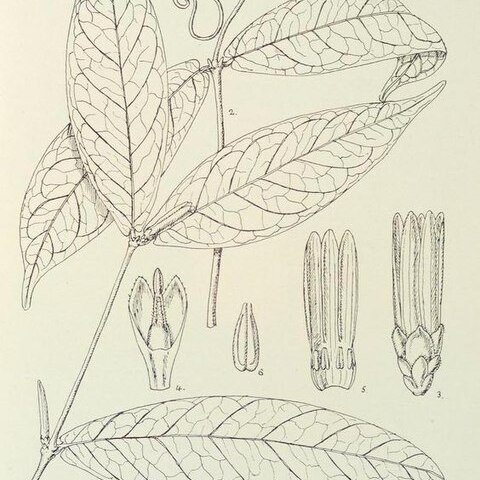Liana up to 40 m high; trunk up to 12 cm in diameter; bark rough, peeling; branches and branchlets lenticellate.. Leaves petiolate, blade (narrowly) elliptic, 4.3–20 cm long, 1.8–8 cm wide, acuminate with the acumen obtuse and 1–15 mm long, cuneate at the base, glabrous on both sides or with scattered glandular hairs especially on the midrib and near the base; petiole 5–12 mm long, glabrous or with scattered glandular hairs.. Inflorescence 1–2 together, 1.5–9.5 cm long, 10–80-flowered; peduncle 1–12 mm long, glabrous or pubescent; bracts 0.6–0.8 mm long.. Flowers with sepals ovate, 0.6–1.3 mm long, 0.5–1 mm wide; corolla tube 3.1–6.4 mm long, widest at the insertion of the stamens, pilose outside, subglabrous above anthers; lobes (narrowly) oblong to (narrowly) ovate or obovate, 1.1–5.2 mm long, 0.5–1.8 mm wide, obtuse at the apex, entire, spreading; stamens inserted at 1–3 mm from the corolla base; anthers ovate, 0.3–0.5 mm long, apiculate, hanging or pointing downwards at anthesis; pistil 0.7–1.3 mm long, never touching stamens; style 0.2–0.4 mm long, glabrous; ovary 1–celled, with 6–15 ovules.. Fruit ± 6.8 cm in diameter, globose or pyriform; exocarp with a hardened layer; seeds 6–25, 9–14 mm in diameter.. Fig. 7 (p. 25).
More
A creeper. It grows to 40-100 m long. The trunk can be 12 cm across. The bark is rough and peels off. The leaves are narrowly oval and 4-20 cm long by 2-8 cm wide. They taper to the tip and are wedge shaped at the base. The fruit are about 7 cm across. They are round or pear shaped and have a harder layer on the outside. There are between 6-25 seeds. They are about 1 cm across.
Fairly small white, greyish or yellowish flowers, the tube mostly pink.
Climber up to 300 ft.long, with tendrils

